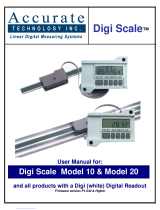
2.1.4. Display Mode
In normal operation, up to 5 different operating variables can be indicated continuously in the
middle section: 1.1, 1.2, and 1.3 as well as 2 and 3.
2.1.5. Display Mode - Selection of Read-Outs
It is possible to toggle between three status
read-out screens by pressing the [Status] key.
Operating variables with different formatting
are shown in each status screen - see below.
The table shows the measurements you can
link to each of the operating variables. Define
the links via par. 0-20, 0-21, 0-22, 0-23, and
0-24.
Each readout parameter selected in par. 0-20
to par. 0-24 has its own scale and digits after
a possible decimal point. By larger numeric
value of a parameter fewer digits are dis-
played after the decimal point.
Ex.: Current readout
5.25 A; 15.2 A 105 A.
Operating variable: Unit:
Par. 16-00 Control Word hex
Par. 16-01 Reference [unit]
Par. 16-02 Reference %
Par. 16-03 Status Word hex
Par. 16-05 Main Actual Value %
Par. 16-10 Power [kW]
Par. 16-11 Power [HP]
Par. 16-12 Motor Voltage [V]
Par. 16-13 Frequency [Hz]
Par. 16-14 Motor Current [A]
Par. 16-16 Torque Nm
Par. 16-17 Speed [RPM]
Par. 16-18 Motor Thermal %
Par. 16-20 Motor Angle
Par. 16-30 DC Link Voltage V
Par. 16-32 Brake Energy / s kW
Par. 16-33 Brake Energy / 2 min kW
Par. 16-34 Heatsink Temp. C
Par. 16-35 Inverter Thermal %
Par. 16-36 Inv. Nom. Current A
Par. 16-37 Inv. Max. Current A
Par. 16-38 SL Control State
Par. 16-39 Control Card Temp. C
Par. 16-40 Logging Buffer Full
Par. 16-50 External Reference
Par. 16-51 Pulse Reference
Par. 16-52 Feedback [Unit]
Par. 16-53 Digi Pot Reference
Par. 16-60 Digital Input bin
Par. 16-61 Terminal 53 Switch Set-
ting
V
Par. 16-62 Analog Input 53
Par. 16-63 Terminal 54 Switch Set-
ting
V
Par. 16-64 Analog Input 54
Par. 16-65 Analog Output 42 [mA]
Par. 16-66 Digital Output [bin]
Par. 16-67 Freq. Input #29 [Hz]
Par. 16-68 Freq. Input #33 [Hz]
Par. 16-69 Pulse Output #27 [Hz]
Par. 16-70 Pulse Output #29 [Hz]
Par. 16-71 Relay Output
Par. 16-72 Counter A
Par. 16-73 Counter B
Par. 16-80 Fieldbus CTW hex
Par. 16-82 Fieldbus REF 1 hex
Par. 16-84 Comm. Option STW hex
Par. 16-85 FC Port CTW 1 hex
Par. 16-86 FC Port REF 1 hex
Par. 16-90 Alarm Word
Par. 16-92 Warning Word
Par. 16-94 Ext. Status Word
Status screen I:
This read-out state is standard after start-up
or initialization.
Use [INFO] to obtain information about the
measurement links to the displayed operating
variables (1.1, 1.2, 1.3, 2 and 3).
See the operating variables shown in the
screen in this illustration.
130BP041.10
1.1
1.3
2
1.2
3
2. How to Programme FC 300 Programming Guide
16
MG.33.M2.02 - VLT
®
is a registered Danfoss trademark
2

























